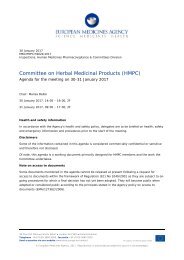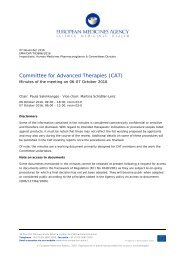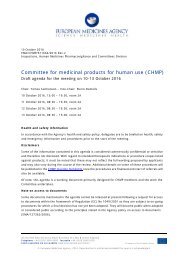Strategic Plan for Food Safety
9789241506281_eng
9789241506281_eng
- No tags were found...
Create successful ePaper yourself
Turn your PDF publications into a flip-book with our unique Google optimized e-Paper software.
ActionsActions31Actions1.1.1. Carrying out independent international risk assessments<strong>for</strong> priority food hazards, including evaluation of thehealth impact of new technologies1.1.2. Developing guidance <strong>for</strong> a systematic approach <strong>for</strong> thedevelopment of rapid risk assessment advice <strong>for</strong> emergingand emergency issues, including a tiered approachto risk assessment (“fit <strong>for</strong> purpose”)1.1.3. Developing an evaluation framework that allows—in additionto safety—the inclusion of other considerations,such as health benefits and socioeconomic consequences1.1.4. Continuing the development of internationally harmonizedrisk assessment methodology reflecting the stateof the science1.1.5. Enhancing awareness and understanding of the interlinkagesand relevance of food safety in the context offood security and promoting systematic integration offood safety into policies and interventions to improvenutrition and food availability1.2.1. Strengthening the public health leadership of internationalstandard-setting bodies such as the CodexAlimentarius Commission and advocating <strong>for</strong> the wideimplementation of international standards1.2.2. Continuing WHO’s support of the Codex AlimentariusCommission1.2.3. Ensuring that the independent scientific advice fromFAO/WHO expert meetings <strong>for</strong>ms the key evidence base<strong>for</strong> Codex standards1.2.4. Developing recommendations, guidelines and/or guidanceto in<strong>for</strong>m policy decisions <strong>for</strong> emerging and emergencyissues1.2.5. Supporting effective participation of developing andtransition economy countries in the work of the CodexAlimentarius Commission1.3.1. Developing databases and tools to collect, improve accessto and interpret relevant data and other in<strong>for</strong>mation1.3.2. Establishing and mapping links between different datasources to facilitate the application and interpretationof combined data and increase ef<strong>for</strong>ts to share dataamong agencies and Member States1.3.3. Strengthening links with national public health systemsto integrate health surveillance and food monitoringdata and improve understanding of their attribution tofoodborne health risks1.4.1. Strengthening the capacity of countries in generatingbaseline and trend data on foodborne diseases1.4.2. Encouraging food safety stakeholders to utilize suchestimates in analyses of the cost-effectiveness of interventionsas well as the development of food safetystandards and policies1.4.3. Providing baseline and trend estimates on the globalburden of foodborne diseases <strong>for</strong> a defined list of causativeagents of microbial, parasitic and chemical origin3.1.1 Assisting countries in analysing and improving theirsystems and legal frameworks, including infrastructure<strong>for</strong> food safety; the cross-linkages and gaps in or constraintsto communication; and collaboration betweenadministrative levels and among sectors3.1.2. Developing and providing practical tools to ministries<strong>for</strong> strengthening cross-sectoral collaboration to addressfoodborne health threats at the national level3.1.3. Working with the animal health sector and other relevantpartners in regions and countries to assess andstrengthen food safety systems and legal structures betweenorganizations and institutions3.2.1. Assisting countries in implementing Codex and otheradequate standards at the national level3.2.2. Assisting countries in the establishment and refinementof systems to monitor, assess and manage food safetyincidents and emergencies2.1.1. Facilitating rapid exchange of food safety in<strong>for</strong>mationamong INFOSAN members and providing technicalsupport to improve response to international foodborneoutbreaks and food safety emergencies2.1.2. Sharing technical in<strong>for</strong>mation on foodborne healththreats to allow identification of data gaps and <strong>for</strong> integratedrisk assessment, prevention and control2.1.3. Establishing cross-sectoral linkages among human andanimal surveillance systems to minimize duplication ofmonitoring, reporting and delivery systems and facilitateintegrated risk assessments2.1.4. Developing an efficient capacity building mechanism tobetter integrate disease and epidemiological data withlaboratory surveillance data2.1.5. Establishing and fostering global frameworks and mechanismsto ensure strategic alignment and collaborationwith other sectors, particularly the agriculture and animalhealth sectors3.3.1. Implementation of food inspection and control serviceswith qualified personnel3.3.2. Development of laboratory capacity at national and regionallevels3.3.3. Introduction of modern in<strong>for</strong>mation management systemsand in<strong>for</strong>mation sharing2.2.1. Developing specific messages and in<strong>for</strong>mation <strong>for</strong> policy-makers,risk managers and end users to promotefood safety along the farm-to-table continuum, includingintegration of food safety in nutrition and food securityprograms2.2.2. Advocating and ensuring that the results of scientificassessments are communicated in an easily understandable<strong>for</strong>m to permit dialogue among stakeholders, includingconsumers2.2.3. Empowering women through food safety educationAnnex 2 represents the strategic plan in an objective tree diagram, illustrating how theproposed actions contribute to the objectives so the three outcomes can be reached. Thisdiagram will facilitate the implementation of the strategic plan and the monitoring of itsachievements.








